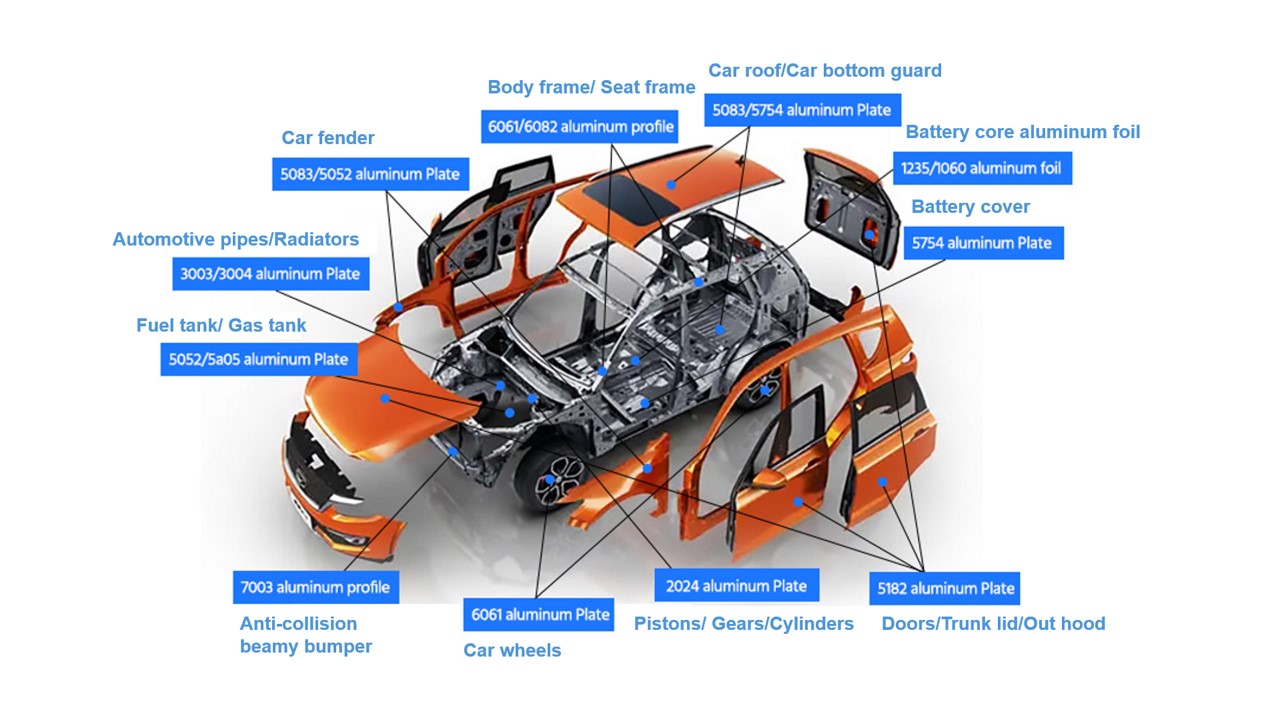1. The Need for Lightweighting
Reducing vehicle weight is a key aspect of modern automotive design. The benefits are clear:
- Every 1% reduction in vehicle weight can save 0.6% to 1.0% in fuel consumption.
- For every 100 kg reduction in vehicle weight, approximately 5 g/km less CO2 is emitted.
- Using just 1 kg of aluminum in a car can save up to 20 kg of emissions over the vehicle’s lifetime.
- As vehicles become more feature-rich, lightweighting helps offset the weight added by these advanced components.
The main targets for weight reduction include the engine, chassis, and body. Among these, the car body is a significant contributor, representing up to 30% of the vehicle’s total weight. Therefore, increasing the use of aluminum in the car body has a pivotal impact on achieving lightweight goals.
2. Methods for Lightweighting
Optimizing Vehicle Frame Structure: Redesigning and optimizing the structural elements of the car.
Material Substitution: Replacing traditional steel with high-strength, lightweight materials such as:
High-strength steel
Aluminum alloys
3. Aluminum Alloys – The Ideal Solution for Automotive Lightweighting
3.1 Aluminum Alloy Fundamentals
Aluminum offers an excellent density-to-strength ratio. Its density of 2.7 g/cm³ is about one-third that of steel (7.8 g/cm³), which allows for approximately 50% weight savings when used as a replacement. Aluminum also naturally forms a stable oxide layer that enhances its corrosion resistance. Furthermore, it boasts good casting properties due to its low melting point and high fluidity, making it easier to manufacture complex components.
By alloying aluminum with other elements, it becomes possible to enhance its strength and hardness. Certain aluminum alloys can be strengthened through heat treatment, achieving tensile strengths of over 600 MPa. Its thermal and electrical conductivity is three times that of steel, adding to its versatility.
3.2 Types of Aluminum Alloys
Aluminum alloys can be broadly classified into two types:
Wrought Aluminum Alloys: These alloys are ideal for pressure processing and can be strengthened through cold deformation and heat treatment.
Cast Aluminum Alloys: These are commonly used for engine parts, housing components, and other vehicle parts.
3.3 Current Application of Aluminum in Vehicles
Cast and wrought aluminum alloys are both utilized in automotive applications. Cast aluminum components are primarily used in the engine, housing, and chassis, while wrought aluminum alloys are employed in car bodies. Applications include hoods, roof panels, doors, fenders, and trunk lids.
Traditionally, Al-Cu-Mg (2000 series), Al-Mg (5000 series), and Al-Mg-Si (6000 series) alloys are used for auto bodies. The lightweight and high-strength properties of aluminum make it a prime choice for use in components such as engine mounts, bumpers, and structural body elements.
4. Aluminum Alloys for Auto Body Panels

4.1 5000 Series Alloys for Inner Panels
The 5000 series alloys, based on aluminum-magnesium (Al-Mg), are non-heat-treatable alloys primarily used for automotive inner coverings and structural components due to their superior formability compared to the 6000 series. Common grades include 5754 and 5182, which offer excellent yield strength control through magnesium content and grain size adjustment, making them ideal for complex panel forming.
| Alloy No. | Si | Fe | Cu | Mn | Mg | Cr | Zn | Ga,V,NI, B,zR,etc. | Ti | Others Individual | Others Total | AL |
| 5052 | 0.25 max. | 0.40 max | 0.10 max. | 0.10 max. | 2.2 to 2.8 | 0.15 to 0.35 | 0.10 max. | — | — | 0.05 max. | 0.15 max. | Remainder |
| 5182 | 0.20 max. | 0.35 max. | 0.15 max. | 0.20 to 0.50 | 4.0 to 5.0 | 0.10 max. | 0.25 max. | — | 0.10 max. | 0.05 max. | 0.15 max. | Remainder |
| 5754 | 0.40 max. | 0.40 max | 0.10 max. | 0.50 max. | 2.6 to 3.6 | 0.30 max. | 0.20 max. | Mn+Cr 0.10 to 0.6 | 0.15 max. | 0.05 max. | 0.15 max. | Remainder |
4.2 6000 Series Alloys for Exterior Panels
The 6000 series alloys contain magnesium and silicon, and sometimes copper, making them heat-treatable and suitable for exterior car panels. Grades such as AA6009, AA6010, AA6016, and AA6111 are used globally, with AA6111 preferred in the United States for its high strength and formability, while EN-6016 is favored in Europe for exterior applications. These alloys offer better formability and corrosion resistance compared to higher-strength copper alloys, making them an excellent choice for high-quality exterior panels.
The shift towards using the 6000 series is driven by Original Equipment Manufacturers (OEMs) seeking higher strength. Currently, over 80% of aluminum alloys used by automotive manufacturers belong to the 6000 series. These alloys offer a balance of high strength, weldability, and formability, making them versatile for various automotive applications.
4.3 Applications of Aluminum-Magnesium Alloys in Chassis
The non-heat-treatable 5000 series alloys also find significant use in automotive chassis components due to their excellent formability during complex shaping processes. For instance, the rear subframe of the BMW 5 Series is made from 3.5 to 4.0 mm thick sheet metal using hydroforming and welded tube construction, providing a high level of functionality and integration.
The latest BMW 7 Series features a mix of tubing and casting that reduces weight to just 14.1 kg, demonstrating the advanced use of aluminum in modern automotive engineering.
5. Conclusion
Lightweighting automotive components with aluminum alloys has become an essential step in the evolution of vehicle design. With aluminum's impressive density-to-strength ratio, excellent corrosion resistance, and versatility in both casting and forming, it plays a pivotal role in enhancing energy efficiency and safety. As the demand for stronger, lighter vehicles grows, the use of 5000 and 6000 series aluminum alloys is likely to expand, offering an optimized blend of strength, formability, and durability.